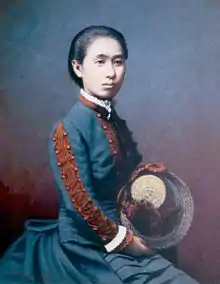Ogino Ginko
Ogino Ginko (荻野 吟子, March 3, 1851 – June 23, 1913) was the first licensed and practicing woman physician of western medicine in Japan.
Ogino Ginko | |
|---|---|
 | |
| Born | March 3, 1851 |
| Died | June 23, 1913 (aged 62) Tokyo, Japan |
| Nationality | |
| Occupation | medical doctor |
Biography
Ogino was born in Musashi province (present-day Kumagaya city, Saitama prefecture).[1] She was married at the age of 16 to the son of the first director of Ashikaga Bank. She soon divorced after contracting gonorrhoea from her husband. After the embarrassment of having to visit male doctors with what was considered a “shameful” disease, she resolved that she would become a doctor to help women in similar circumstances. After graduating from Tokyo Women's Normal School (present-day Ochanomizu University), which was at that time a private medical academy with an all-male student body. Despite prejudice and much hardship, she graduated in 1882, and after numerous petitions, was finally allowed to take her medical practitioner's examination in 1885.
She opened the Ogino Hospital in Yushima, specializing in obstetrics and gynecology, in Tokyo the same year as the first registered woman doctor in Japan. She also served as staff doctor to the girls' school of Meiji Gakuin University.
Ogino married a Protestant clergyman and utopian visionary, Yukiyoshi Shikata, in 1890, and went with him to Hokkaidō in 1894, where she ran a medical practice. After her husband died, she returned to Tokyo and in 1908 resumed running a hospital. She was also active in the Woman's Christian Temperance Union (WCTU).
Ogino died of atherosclerosis in 1913. She is buried at Zoshigaya Cemetery in Tokyo.
References
- Hoffman, Michael (August 25, 2018), "The efforts of Japan's first female doctor are worth remembering", The Japan Times
External links
| Wikimedia Commons has media related to Ogino Ginko. |